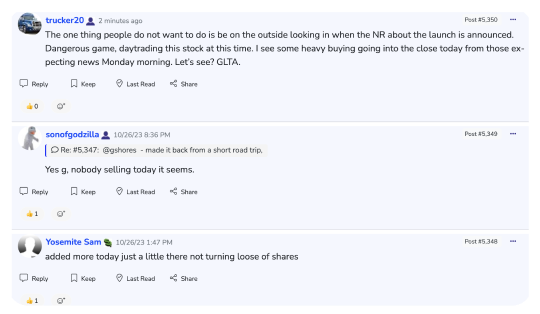Monday, April 10, 2023 7:01:18 AM
I did a little research and add the 2 Italian members Riccardo Soffietti (EANO President 2012-2014) and Roberta Rudà in bold.
EANO
The Publishing Activity Committee (Wolfgang Wick, DE (Chair), Martin Taphoorn, NL (co-chair), Linda Dirven, NL, Francois Ducray, FR, Norbert Galldiks, DE, Monika Hegi, CH, Martin Klein, DE, Katrin Lamszus, DE, Simone Niclou, LU, Matthias Preusser, AT, Patrick Roth, CH, Roberta Rudà, IT, Felix Sahm, DE, Susan Short, UK, Riccardo Soffietti, IT, Martin Van den Bent, NL, Michael Weller, CH, Pieter Wesseling, NL) consists of editors that represent EANO in the following journals: Neuro-Oncology, Neuro-Oncology Practice and Neuro-Oncology Advances.
https://investorshub.advfn.com/boards/read_msg.aspx?message_id=171646692
Their college Francesco Pasqualetti and Post-Doc researcher Sofia Zanotti are the authors of this recent publication ( Feb.15, 2023):
Nonrandomised controlled trial in recurrent glioblastoma patients: the promise of autologous tumour lysate-loaded dendritic cell vaccination
https://www.nature.com/articles/s41416-023-02194-1
Francesco Pasqualetti
Following my training in Clinical Oncology at the University of Pisa, from June 2008 to December 2020, I held the position of consultant at Pisa University Hospital, where, from 02/01/2015 to 26/12/2020, I looked after the neuro-oncology multidisciplinary team. I hold a PhD in Clinical Pharmacology, and, in the latter years, my research has been focused on translational studies carried out in brain cancer patients, a new growing field of study in oncology.
Thanks to a fellowship cofounded by the Marie Curie Actions and the Italian Association on Cancer Research (iCARE-2), since January 2021, I have been working for the Department of Oncology of the University of Oxford (Computational Biology and Integrative Genomics lab, headed by Professor Francesca Buffa). By combining artificial intelligence with liquid biopsy, my research aims to explore new approaches for brain tumor patients.
https://www.oncology.ox.ac.uk/team/francesco-pasqualetti
Sofia Zanotti
Postdoctoral Researcher
While born and raised in Italy, I obtained my Undergraduate and Master degree in London and my PhD in Belgium. I am currently a Post-Doc researcher for hepatocellular carcinoma in Prof. Terracciano's lab (Humanitas Research Hospital, Milan).
My research experience allowed me to gain a multidisciplinary skill set, ranging from cell culture handling and drugging over microscopy and image analysis to deep transcriptomics.
The Post-Doc position main topic is focusing on single-cell dissection of the cellular ecosystem in hepatocellular carcinoma.
https://www.linkedin.com/in/sofia-zanotti-63118410b/?originalSubdomain=it
Nonrandomised controlled trial in recurrent glioblastoma patients: the promise of autologous tumour lysate-loaded dendritic cell vaccination
Francesco Pasqualetti & Sofia Zanotti
British Journal of Cancer (2023)
Summary
Recently, Liau et al. reported the results of Phase 3 clinical trial testing DCVax-L vaccines on patients with glioblastoma. Despite the promising and significant results obtained, the study design and the long-lasting period of recruitment of this work deserve some reflection.
Glioblastoma (GB) is a malignant tumour that is thought to arise from neural stem cells or progenitor cells residing in the central nervous system. About 90% of the GB cases are diagnosed as primary GB and undergo intensive multi-modal therapy [1]. However, despite the advances recorded in many other solid cancers, the success rate of current treatments for GB is disappointingly low and survivors suffer from multiple therapy-related long-term side effects, warranting the urgent need for more effective therapies [1,2,3]. After decades of intensive research, most attempts to further improve GB therapies within randomised trials failed to deliver significant results. The success rate of current agents tested in combination with radiotherapy remains disappointingly low as there is no additional advantage in terms of overall survival (OS).
Immunotherapies have long been considered a promising form of cancer treatment that exploit the patient’s immune response against tumours [4]. In essence, immunotherapy compounds act by interfering with immune checkpoint blockade agents, but can also be based on monoclonal antibodies or therapeutic vaccines [5]. Moreover, the stimulation of the immune system was shown to work synergistically with checkpoint inhibitors by producing a strong antitumor immune response [6]. The lysate-loaded dendritic cell (DCVax-L) vaccine is a cell-based vaccine able to stimulate a polyclonal T-cell response by triggering the antigenic repertoire of the patient’s own dendritic cells. Recently, Adam and colleagues discussed the efficacy of DCVax-L vaccines in combination with other standard systemic therapies in the melanoma field, a characteristically immunogenic cancer [7]. Their work suggests that the DCVax-L vaccine is well tolerated and can be adopted as a treatment option in patients with recurrent and metastatic melanoma [7]. Although the DCVax-L vaccine can trigger the patient’s immune response, specifically T cells, it remains a therapy that has to be accompanied by additional therapeutic agents and has thus found minor success as monotherapy.
Recently, Liau et al. reported the results of Phase 3 clinical trial testing DCVax-L vaccines on patients with either newly diagnosed or recurrent GB. The trial has called attention to the beneficial relevance of DCVax-L vaccines by observing a significant improvement in OS of GB patients [8]. This data could be suggesting that the combination of the DCVax-L vaccine and standard of care may offer the ability to initially cause a T-cell response and further protect the T cells from immunosuppression. To overcome the limits related to the use of a cross-over design in assessing the impact of DCVax-L in OS, an external control group composed by patients treated with standard of care (radiotherapy with TMZ) within selected randomised trials were included.
The authors showed promising results of the DCVax-L vaccine in respect to the external cohort of patients. The median survival from the date of randomisation of the patients treated with the DCVax-L vaccine was 19.3 months (95% CI, 17.5–21.3) whereas for the 1366 patients in the control group was 16.5 months (95% CI, 16.0–17.5) (log-rank HR, 0.80; 95% CI, 0.00–0.94; P?=?0.002). Survival at 48 months after randomisation was reported to be 15.5% and 9.9% in the treated and control arms, respectively. Despite the promising and significant results obtained, the study design and the long-lasting period of recruitment of this work deserve some reflection.
The studies that analysed a selected control group showed a significant overlap of clinical characteristics and enrolment period when compared to the work performed by Liau and colleagues (from 2007 to 2015). However, the choice of patients enrolled in the control group from different clinical trials cannot entirely eliminate the limitations encountered when adopting a cross-over design, even if matched by several criteria [9]. Upon further evaluation of the studies selected by Liau et al. to assess the impact of the vaccine in patients with newly diagnosed GB, the authors reported incomplete demographic and clinical characteristics. For example, the information about the patient’s age was missing in 2/5 trials and the assessment of the extent of resection, thus an indicator for the persistence of residual disease was not included for 3/5 trials. Similarly, three of the comparison studies on the recurrence of GB did not provide data on age while for five studies the definition of MGMT was absent. Furthermore, IDH mutations were not evaluated in any of the selected studies. Yet, the authors performed an accurate randomised part of the study as, in addition to standard radio-chemotherapy, 99 patients received a placebo whereas 232 the active treatment. Nevertheless, the results of this randomisation should be further analysed by intention to treat [10].
Moreover, the long duration of the enrolment period indicates that the criteria adopted for recruiting GB patients do not consider the latest WHO classifications [1]. Consequently, this suggests that the patients alive at 48 months might have less aggressive tumours, thus an IDH 1 and 2 mutated glioma. Finally, although it is accepted that the pseudo-progression might be an issue when assessing an actual disease recurrence, analysis of progression-free survival did not show significant differences between immunotherapy-treated patients and controls.
To demonstrate that the efficacy of the new DCVax-L-based therapy provides additional benefits in comparison to the standard of care, the results reported by Liau et al. should be confirmed by a randomised trial. Further studies should also evaluate the effect of the DCVax-L vaccine in combination with other standard systemic therapies routinely used for the treatment of GB. Considering the challenges encountered during the planning of clinical studies for newly diagnosed GB without accounting for the cross-over effect after progression, recurrent GB that were not previously treated with the DCVax-L vaccine could be regarded as the most suitable setting for planning prospective randomised trials. Appropriate novel trial designs, for example, window trials, could be considered.
An important underlying theme to many of the recommendations made is that trial-based studies should ensure standardisation of data acquisition and analysis. This in turn, may be exploited to valorise the potential of DCVax-L vaccine-based therapies which are gradually being unveiled and could provide guidance towards additional therapy options in the GB field.
Recent NWBO News
- Form 8-K - Current report • Edgar (US Regulatory) • 06/04/2024 09:11:16 PM
- Form DEF 14A - Other definitive proxy statements • Edgar (US Regulatory) • 06/03/2024 09:22:55 PM
- Form PRE 14A - Other preliminary proxy statements • Edgar (US Regulatory) • 05/22/2024 08:13:36 PM
- Form 10-Q - Quarterly report [Sections 13 or 15(d)] • Edgar (US Regulatory) • 05/10/2024 09:04:57 PM
- Form NT 10-K - Notification of inability to timely file Form 10-K 405, 10-K, 10-KSB 405, 10-KSB, 10-KT, or 10-KT405 • Edgar (US Regulatory) • 03/01/2024 10:04:38 PM
- Form 4 - Statement of changes in beneficial ownership of securities • Edgar (US Regulatory) • 12/02/2023 01:31:35 AM
- Form 8-K - Current report • Edgar (US Regulatory) • 11/16/2023 10:11:54 PM
- Epazz, Inc. (OTC Pink: EPAZ) ZenaDrone Demonstration to Defense Departments of UAE and Saudi Arabia • InvestorsHub NewsWire • 11/15/2023 12:19:31 PM
- Form 10-Q - Quarterly report [Sections 13 or 15(d)] • Edgar (US Regulatory) • 11/09/2023 09:30:39 PM
- Epazz, Inc. (OTC Pink: EPAZ) US Navy Collaboration ZenaDrone 1000 • InvestorsHub NewsWire • 11/09/2023 01:00:34 PM
- Epazz, Inc. (OTC Pink: EPAZ) US Navy Collaboration ZenaDrone 1000 Extreme Weather Demo • InvestorsHub NewsWire • 11/07/2023 12:29:43 PM
- Form 10-Q - Quarterly report [Sections 13 or 15(d)] • Edgar (US Regulatory) • 08/09/2023 08:36:14 PM
Mushrooms Inc. (OTC: MSRM) Announces Significant Share Buy Back by the Board Director and New Strategic Initiatives. • MSRM • Jun 5, 2024 1:32 PM
Hydromer Announces Launch of HydroThrombX Medical Device Coating Technology • HYDI • Jun 5, 2024 10:24 AM
Dr. Michael Dent Finances $1 Million to Drive HealthLynked's Healthcare Transformation • HLYK • Jun 5, 2024 8:00 AM
Avant Technologies Enters Binding LOI to Purchase Dozens of High-Performance, Immersible, AI-Powered Servers • AVAI • Jun 5, 2024 8:00 AM
IQST - iQSTEL Announces $290 Million 2024 Annual Revenue Forecast • IQST • Jun 4, 2024 1:43 PM
ECGI Holdings Accelerates Strategic Initiatives by Securing First of Two $125,000 Convertible Notes • ECGI • Jun 4, 2024 12:15 PM









